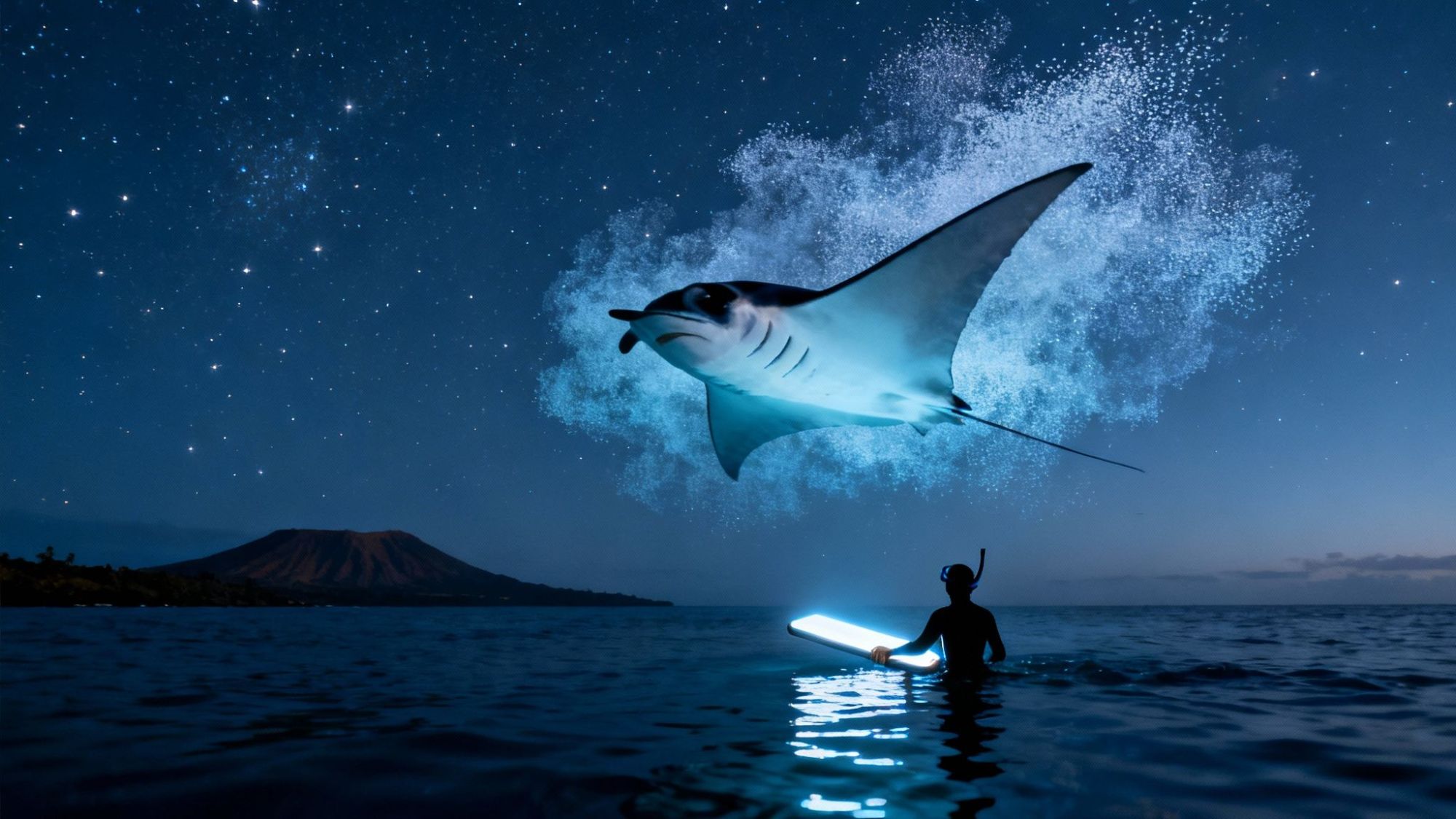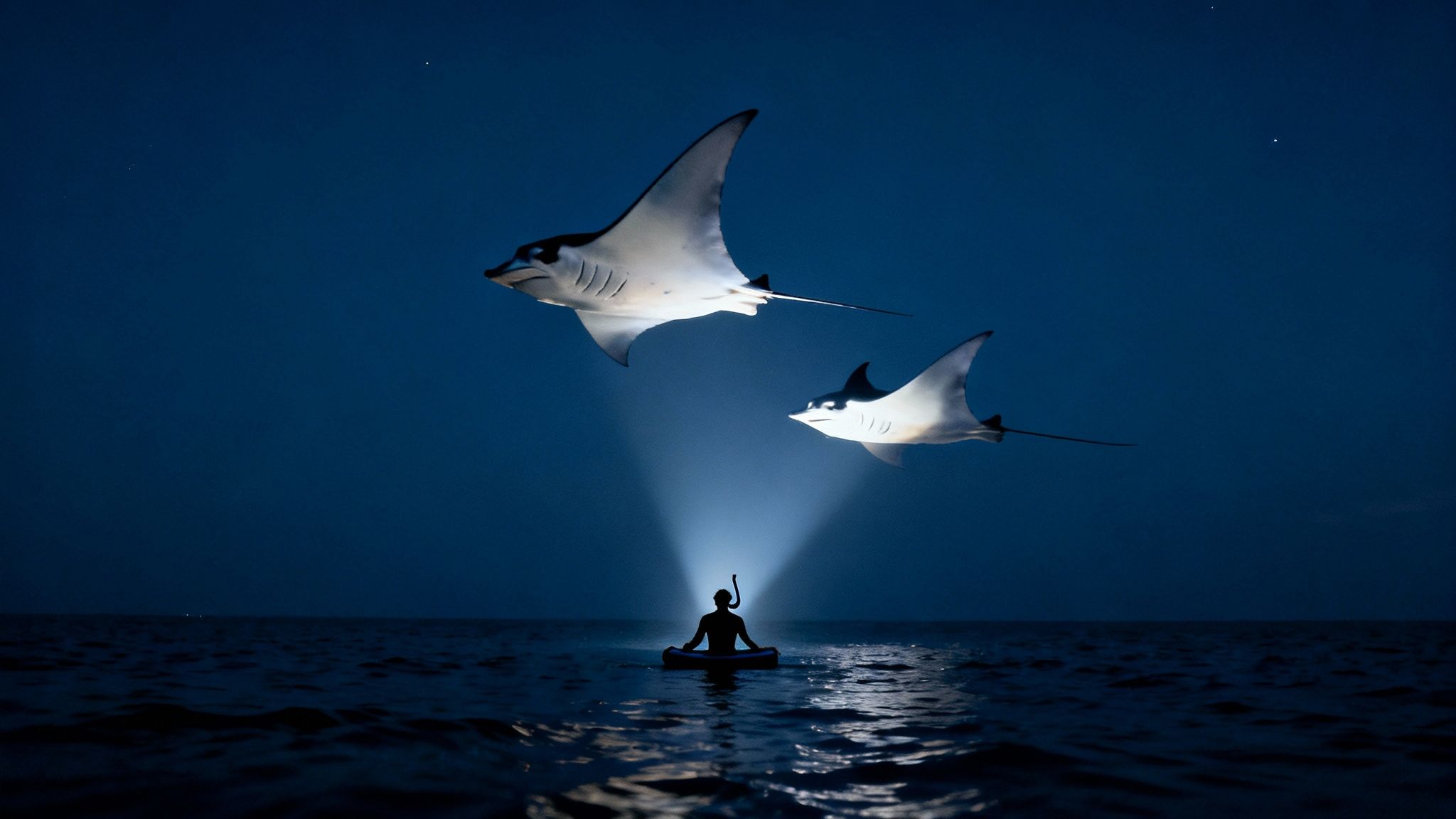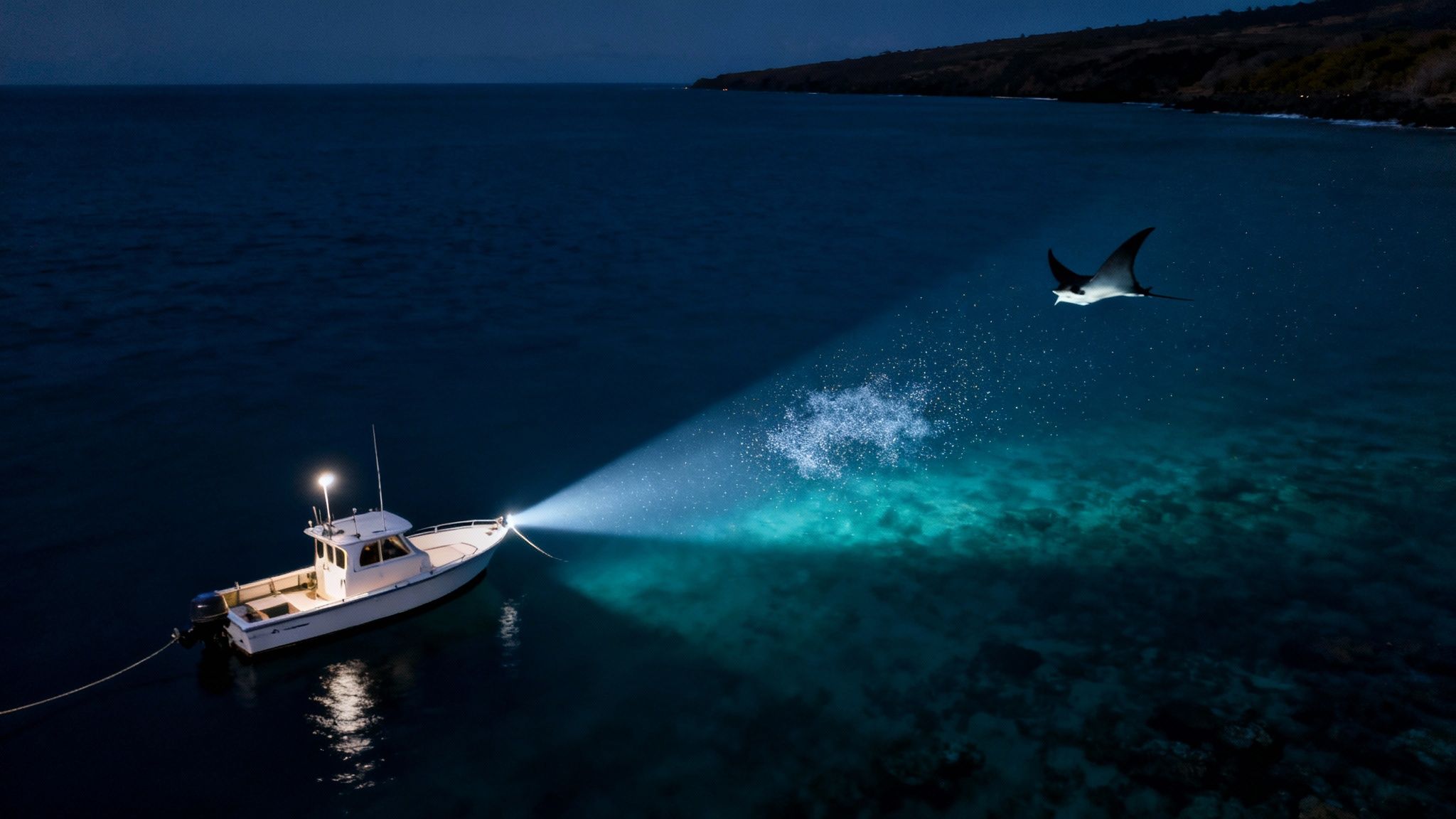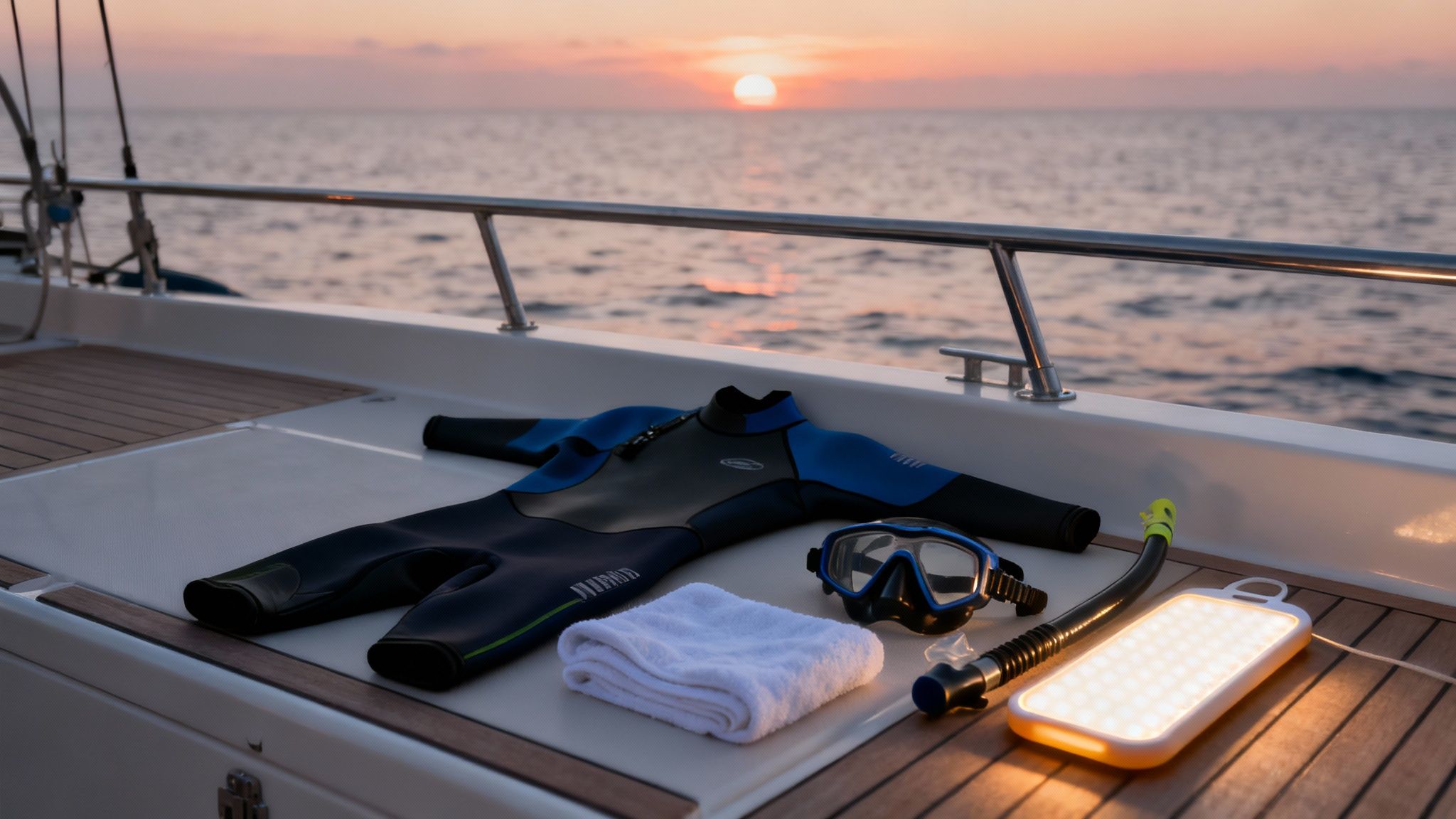Kona: Manta Ray Night Snorkel Kona – A Complete Guide

Picture this: you're floating weightlessly on the calm, dark surface of the Pacific. Just inches below, giant, gentle manta rays swoop and dance in beams of light. It's not a dream—it's the manta ray night snorkel in Kona, easily one of Hawaii's most mind-blowing wildlife encounters.
This guide will walk you through everything you need to know, from picking the right crew to take you out to what it actually feels like when a creature with a 16-foot wingspan soars right under you.

Why This Kona Adventure Is a Must-Do
The manta ray night snorkel consistently lands at the top of every "Best of the Big Island" list, and for good reason. It’s your chance to witness an incredible natural feeding spectacle in a totally safe, guided environment.
When you're ready to book, we recommend going with Kona Snorkel Trips, the top rated & most reviewed snorkel company in Hawaii. They're widely known for providing an exceptional experience, so you know you're in good hands.
Just see what fellow adventurers have to say about them.
So, what exactly makes this so special?
- Unbelievably Close Encounters: You'll see these majestic creatures glide, barrel roll, and feed just inches from your face. It's an intimate and humbling experience you won't get anywhere else.
- A Natural Phenomenon: The tour boats use bright lights to attract plankton, which is the mantas' favorite food. This essentially rings a dinner bell, drawing them in for a feeding frenzy right below you.
- Anyone Can Do It: Worried about your swimming skills? Don't be. You just hold onto a custom-built, floating light board, making it a comfortable and secure experience for nearly all ages and abilities.
Stick with us, and we'll dive into what truly makes Kona the world's best place for meeting these gentle giants of the ocean.
Why Kona Is The Best Place to See Manta Rays
So, what makes the Kona coast the undisputed global hotspot for manta ray encounters? It's really a perfect storm of unique underwater geography and a brilliant, sustainable tourism model that's been dialed in over the years. This combo creates a world-class wildlife interaction you can actually count on, not just hope for.

It all starts with the island's volcanic slopes. They’ve created the ideal habitat where deep, nutrient-rich currents push massive amounts of plankton—the manta ray's favorite meal—right up to the surface. Think of it as a nightly plankton buffet that naturally draws in the local manta population, night after night.
The Famous Manta Hotspots
Tour operators have zeroed in on two main locations for the manta ray night snorkel in Kona, both offering incredibly reliable sightings.
- Manta Village: Right off the coast of the Sheraton Kona Resort, this is the original viewing site. It's famous for its consistency and has been delivering amazing encounters for decades.
- Manta Heaven: Located just north of Kailua-Kona, this spot often attracts a larger "fever" of mantas, treating snorkelers to a spectacular underwater ballet.
At these sites, tour boats anchor up and drop powerful, eco-friendly lights into the water. These lights act like a giant magnet for plankton, creating a concentrated feeding zone that the mantas simply can't resist. It’s a simple, yet genius method that explains why the experience is so dependable.
Kona's reputation is built on a strong foundation of marine environmental protection and conservation. These efforts are crucial for maintaining the healthy ecosystem these magnificent creatures rely on.
This ingenious setup is what makes the whole thing work so well. In fact, the manta ray night snorkel in Kona brings in around 80,000 participants annually, and operators report a sighting success rate between 80% and 90% all year long. It's a truly magical marine experience.
While the mantas are definitely the main event after dark, Kona's coastline is packed with incredible underwater sights day and night. Be sure to explore the best snorkeling spots in Kona to see what else you can discover just beneath the waves.
How to Choose Your Manta Ray Snorkel Tour
Picking the right operator for your manta ray night snorkel in Kona is probably the most critical decision you'll make for this trip. This one choice impacts everything—your safety, your comfort, and how truly mind-blowing your encounter with these gentle giants will be. It’s about so much more than just finding the cheapest price; it's about setting yourself up for an unforgettable, respectful, and downright incredible experience.
When you start looking, you'll find everything from nimble, small-group boats to massive, double-decker catamarans. Each offers a completely different vibe. For a top-tier, intimate experience, we always point people toward the manta ray night snorkel tour offered by Kona Snorkel Trips. Their whole operation is built around smaller groups for a more personal outing.
As another fantastic option, Manta Ray Night Snorkel Hawaii is an exceptional alternative when looking for a Manta Ray night snorkel tour. Their website has all the details on what they offer.
Small Boat vs. Large Boat Tours
The size of the boat really defines the whole feel of the tour. A smaller boat, like the ones used by Kona Snorkel Trips, naturally means a smaller, more tight-knit group. This usually translates to more personal attention from the guides, a quicker ride out to the snorkel site, and a much less crowded feeling once you're in the water. It’s the perfect fit if you're after a more personal connection with the whole experience.
On the flip side, a larger vessel often comes with more creature comforts—think on-board restrooms, snack bars, and a much smoother ride. That can be a game-changer if you’re worried about getting seasick. The trade-off? These tours pack in more people, so you'll be sharing that magical in-water view with a much bigger crowd.
Choosing between a small boat and a large boat tour is a personal decision that depends on your priorities. Do you value an intimate, personalized experience, or are amenities and a smoother ride more important? This table breaks down the key differences to help you decide.
| Feature | Small Boat Tour (e.g., Kona Snorkel Trips) | Large Boat Tour |
|---|---|---|
| Group Size | Typically 6-20 passengers for a more intimate feel | Can be 40+ passengers, sometimes even up to 100 |
| Atmosphere | Personal, quiet, more one-on-one guide interaction | Social, lively, sometimes feels like a party boat |
| Travel Time | Faster trip to and from the manta site | Slower, more leisurely cruise to the site |
| Amenities | Basic; often no restroom on the smallest boats | More amenities like restrooms, showers, and snack bars |
| Ride Comfort | Can be a bumpier ride in choppy seas | Generally a smoother, more stable ride |
| In-Water Experience | Less crowded on the light board, more space | Can be very crowded, potential for fins in your face |
| Best For… | Adventurous snorkelers, photographers, couples | Families with young kids, those prone to seasickness |
Ultimately, both options will get you in the water with the mantas. The key is to pick the tour that aligns with the kind of night you want to have.
The key is to match the tour style with your personal preference. Do you prefer an intimate, fast-paced adventure or a more stable, amenity-rich excursion? Answering this will guide you to the perfect operator.
Beyond just the boat, dig into the crew's expertise and the company’s commitment to safety and marine conservation. A truly experienced guide does more than just keep you safe; they enrich the whole experience, sharing insights into manta behavior and the local ecosystem. They know exactly how to position the light board to give you the best views without ever disturbing the animals.
Look for operators who mention following the Manta Ray Green List standards, even though the list itself is no longer active. It’s a good sign they’re committed to responsible tourism. Making an informed choice here is what guarantees you’ll be comfortable, safe, and get the absolute most out of this once-in-a-lifetime adventure.
Ready to book an unforgettable trip?
Getting Ready For Your Night Snorkel Adventure
A little bit of prep work is all it takes to turn a good night out with the mantas into a truly unforgettable one. Knowing exactly what to bring—and what to leave at home—will have you feeling confident and ready for your manta ray night snorkel in Kona. The best part? The tour operators provide all the big stuff, so you can pack surprisingly light.

There’s no need to lug your own snorkel, mask, or fins to the boat unless you have a personal set you absolutely love. Every reputable tour provides high-quality, sanitized gear for you. More importantly, they give you a wetsuit (usually a wetsuit top), which is a non-negotiable for staying comfortable in the cooler night water. This means you can just relax and focus on the incredible show happening below you without getting chilled.
Your Personal Packing List
While the big gear is covered, a few personal items will make your adventure that much smoother. Here’s a simple checklist of what you should have with you:
- Swimwear: The pro move is to arrive with your swimsuit already on under your clothes. It saves time and hassle at the harbor.
- Towel and Dry Clothes: You'll be so glad to have something warm and dry to change into for the boat ride back. A hoodie or a light jacket is perfect.
- Reusable Water Bottle: It's always a good idea to stay hydrated, especially after spending time in saltwater.
- Seasickness Medication: If you're prone to motion sickness, take your preferred medication before you get on the boat. While the ride is usually short, it's always better to be safe than sorry.
For a deeper dive into what to wear in the water, take a look at our guide on what to wear for snorkeling.
A question we get all the time is whether you need to be an expert swimmer. The answer is a definite no. You'll be holding onto a large, stable flotation board for the entire experience. There's no real swimming involved; you just float and let the magic unfold right below you.
This experience is designed to be accessible for everyone. The wetsuit gives you extra buoyancy, and the light board provides a secure handhold, making it safe and enjoyable for snorkelers of all skill levels.
Before heading out, it never hurts to brush up on some essential boating safety tips. A little preparation goes a long way in building confidence, allowing you to fully relax and immerse yourself in the wonder of the manta rays.
What The Manta Ray Encounter Is Really Like
Your trip starts with a boat ride as the Kona sun melts into the horizon, splashing the sky with fiery oranges and deep purples. This isn't just about getting from point A to point B; it's a chance to soak in the view and feel the excitement build. The crew will run through a safety briefing, making sure everyone is comfortable and knows what to expect before the real show begins.

Once the boat anchors, the crew gets to work setting up the 'light board'. This is a floating platform they've built with powerful lights pointing straight down into the water. It’s the key to the whole operation. As soon as it hits the ocean, it becomes a beacon for tiny, microscopic plankton. You’re basically helping set the dinner table for some very big, very graceful guests.
Slipping Into Another World
Then, it’s your turn. You'll slide into the warm Pacific, which feels surprisingly welcoming in the dark. You grab onto the light board and float on the surface, looking down into the bright cone of light below you. The feeling is hard to describe. You watch the plankton gather, swirling like a blizzard in the beams. The world above the water just fades away, and all that's left is you and this glowing blue circle.
The first time you see one is a moment that sticks with you. A massive, dark shape just materializes out of the blackness, gliding right into the light. It's the first manta. They perform this incredible underwater ballet, doing graceful barrel rolls sometimes just inches from your mask to scoop up mouthfuls of plankton. These gentle giants can have wingspans of over 12 feet, and seeing them move so effortlessly is breathtaking.
The whole idea behind the manta ray night snorkel in Kona is to be a quiet observer. By holding onto the board and staying still, you become part of the scenery. This lets the mantas come in close without feeling threatened, making the encounter safe and magical for everyone—you and the rays.
Meeting The Locals
There’s a good chance you’ll meet a local celebrity, too. Researchers and guides in Kona have been tracking these mantas for years and can identify them by the unique spot patterns on their bellies. You might see well-known regulars like 'Lefty' or 'Big Bertha', who have been showing up to these feeding sites for decades. It's a powerful reminder of how special this ecosystem is. You can discover more about how these incredible animals are tracked through the ongoing research efforts.
The entire experience is completely silent and awe-inspiring. The only sounds are the water lapping against the board and the occasional muffled gasp from another snorkeler. Watching these magnificent creatures feed with such elegance is a truly humbling experience, a peek into the amazing world just under the surface.
Common Questions About The Manta Ray Night Snorkel
Even the most seasoned travelers have a few questions before hopping in the water with giant manta rays at night. It's totally normal! Let's tackle some of the most common things people ask so you can feel completely ready before you even step on the boat.
Is The Snorkel Safe For Beginners?
Absolutely. You really don’t need to be a world-class swimmer for this experience. In fact, you barely have to swim at all.
Tour operators set you up with great flotation gear, usually a wetsuit top that adds buoyancy and a big, stable light board. You just hang onto the board and float on the surface while the magic happens below. Plus, there are always professional guides in the water making sure everyone is safe and having a great time.
What If No Manta Rays Show Up?
This is a big one, and it's a fair question. These are wild animals, after all, and there's never a 100% guarantee.
That said, the success rate in Kona is ridiculously high, often hovering between 80% and 90%. The vast majority of reputable tour companies offer a "manta guarantee." If your tour is one of the rare unlucky ones, they'll typically let you come back another night for free (just check for availability). It's always a good idea to confirm their specific policy when you book.
Will I Get Cold In The Water?
Even in Hawaii, the water can feel a little brisk after the sun disappears. Don't worry, they've got you covered.
Every tour company provides wetsuits—usually a top or a "shorty" suit. These work by trapping a thin layer of water between the suit and your skin. Your own body heat warms that water up in no time, creating a cozy little barrier that keeps you comfortable for the entire snorkel.
For a deeper dive into these questions and many others, check out our complete guide to manta ray FAQs.
